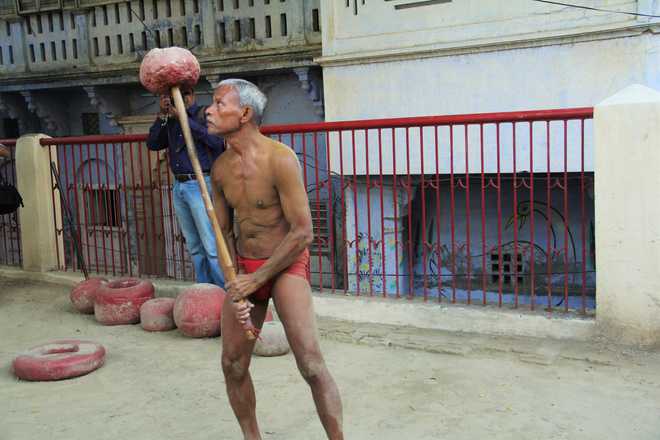
Muscle matters: Turmeric, curd, mustard oil and neem leaves are mixed with mud in the akharas as they are said to infuse it with therapeutic properties. Photos by the writer
Kalpana Sunder
Men of all ages clad only in a loincloth, who look like Indian versions of Sylvester Stallone, wrestle in mud pits, practicing a traditional form of wrestling called kushti or pehelwani. With their limbs entangling, they grunt and heave as they push their opponents away. From the time of the Mahabharata, India has had a rich tradition of wrestling. Hanuman, the monkey god, was considered one of the greatest wrestlers. Varanasi, one of the oldest inhabited cities of India, has old-fashioned gyms called akharas, where men of all ages workout with age-old weights and practice their moves. It is said kushti has Central Asian influences from the Mughals and Persian culture too.
One of the oldest akharas in the city, the Tulsi akhara on Tulsi Ghat, is believed to have been established more than 5,000 years ago by poet Tulsidas. The day starts here with a prayer session at the tiny shrine behind the mud rink devoted to Lord Rama and Hanuman. Young men train here under the tutelage of doyen Siyaramji. They do some stretches, push-ups and squats as warm-up before trying their hand at different kushti equipment.
Some swing around a mace or gadha expertly around their heads, others lift weights nonchalantly, and some others run cartwheels. There are many levels of competitions open to the students and a talented student can even make his way to the national-level competition. What is amazing is that all of them pursue this as a passion and have other careers from insurance and banking to running a shop; some are students at schools and colleges.
The wrestling pit itself is filled with soft earth refilled at regular intervals from nearby fields. According to Siyaram Pehelwan, this is not just any mud — it is mud that is brought from nearby villages and seasoned by mixing it with turmeric, curd, mustard oil and neem leaves to infuse it with therapeutic properties so that the wrestlers stay healthy, and don’t catch any infection. Exercise, health and diet regimens dominate your life once you join an akhara. Strict diet and celibacy as well as an avoidance of alcohol, tobacco, and paan are a must for the students of kushti.
There was a time when the city had more than 500 akharas but the number has fallen due to the emergence of modern gyms in this ancient city. At present, kushti is only practiced in a handful of akharas. Even here, the future of the sport is uncertain due to dwindling funds and the falling number of students. There is a lot of pressure on traditional kushti schools to embrace international wrestling standards. But there is still hope with people like Siyaram, who are ensuring that this ancient art of body building stays afloat.



























